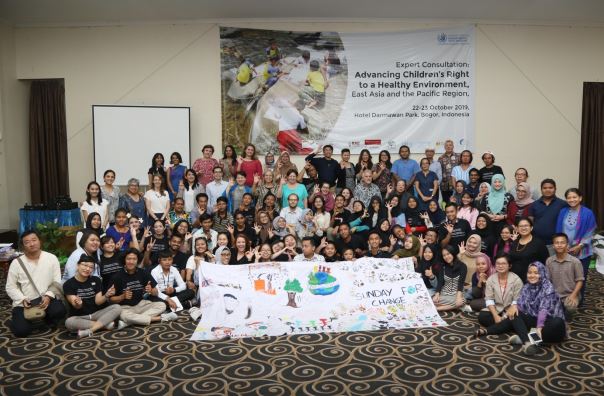Global Initiative on Advancing Children’s Right to a Healthy Environment
Outcome Report for the Regional Expert Consultation for East Asia and the Pacific
Bogor, Indonesia: 22-23 October 2019

The Global Initiative on Advancing Children’s Right to a Healthy Environment was launched in early 2019. The Initiative aims to build on positive progress made in connecting the fields of child rights and environmental issues to date, recognising that the Convention on the Rights of the Child is consistently overlooked in setting and implementing environment-related policies and standards. This is achieved via a series of regional consultations that seek to empower children and youth in relation to their rights, and to provide a unique forum for knowledge exchange and learning among a diverse set of key stakeholders on region-specific challenges, priorities, and promising “best practice” initiatives. Crucially, consultations seek to explore avenues for promoting tangible action at national, regional and international levels to promote recognition and implementation of children’s right to a healthy environment.
In the East Asia Pacific region, rapid economic growth, urbanization, changing lifestyles, and climate change represent important factors driving environmental challenges that undermine children’s rights, including air and water pollution, the use of chemicals and pesticides, unsustainable use of natural resources and mining, land degradation, deforestation and loss of biodiversity, urban environmental issues and waste management,
and significant climate-related impacts, including rising temperatures, wildfires, increasingly severe extreme weather events and sea-level rise.
Countries in the East Asia Pacific region are all signatories of key Multilateral Environmental Agreements (MEA) with respect to climate change, protection of the ozone, desertification and biodiversity. The vast majority have also ratified environmental treaties concerning control of hazardous wastes and certain pollutants. While very few of these international agreements incorporate specific provisions on children, their implementation is essential for upholding children’s rights. At the regional level, the ASEAN agreement to control transboundary haze pollution and the Agreement on Cooperation for the Sustainable Development of the Mekong River Basin are of particular relevance. Neither agreement mentions children.
In parallel, all countries in the region have ratified the Convention on the Rights of the Child. In addition, the ASEAN Human Rights Declaration4 specifically highlights the rights of children, affirms the rights confirmed in the Universal Declaration on Human Rights, and goes beyond these by explicitly recognising ‘the right to safe drinking water and sanitation’ (Art 28.e), ‘the right to a safe, clean and sustainable environment’ (Art
28.f), and the ‘right to development…aimed at poverty alleviation, the creation of conditions including the protection and sustainability of the environment…’ (Art. 36).5 The ASEAN Intergovernmental Commission on Human Rights has convened several workshops on human rights, environment and climate change, and is exploring a regional strategy for a rights-based approach to environmental impact assessments. In 2015, the ASEAN Commission on the Promotion and Protection of the Rights of Women and Children adopted a set of recommendations for tackling the challenges and social impact of climate change on women and children. The Pacific region does not have a common framework on human rights, although the Pacific Plan contains a commitment to promote and protect, inter alia, human rights, gender and youth in the region, and also addresses sustainable development as one of four key pillars.
Recent developments of interest include the child-led complaint to the UN Committee on the Rights of the Child to protest lack of government action on the climate crisis.The 16 child petitioners aged 8-17 include children from the Marshall Islands and Palau.
Read the rest of the report here.
